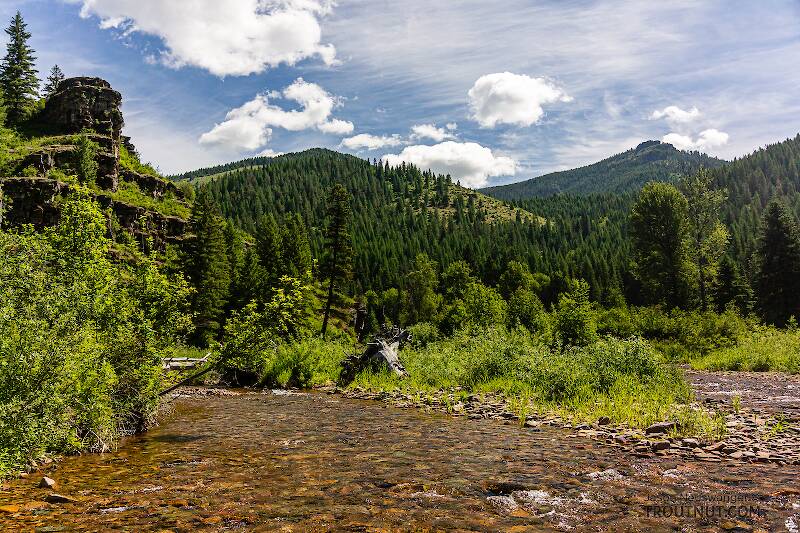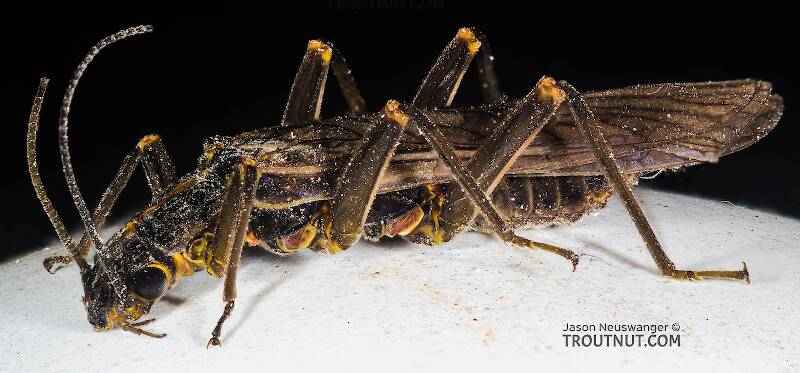
Salmonflies
Pteronarcys californica
The giant Salmonflies of the Western mountains are legendary for their proclivity to elicit consistent dry-fly action and ferocious strikes.
Featured on the forum

Troutnut is a project started in 2003 by salmonid ecologist Jason "Troutnut" Neuswanger to help anglers and
fly tyers unabashedly embrace the entomological side of the sport. Learn more about Troutnut or
support the project for an enhanced experience here.
GoofusBug
Posts: 31
Posts: 31
GoofusBug on Jan 6, 2009January 6th, 2009, 2:39 pm EST
So I am reading an old 1950s era fishing book by Maynard Reece. Great illustrations.
In the flies section, Maynard gives equal time to dries, wets, nymphs, streamers and terrestrials.
These days I seem to hear of fishermen using everything but the wet flies. The classic silver doctor or mormon girl patterns have gone by the wayside. About the only "wet flies" I hear being used are soft hackles.
Any wet fly afishyanados out there?
In the flies section, Maynard gives equal time to dries, wets, nymphs, streamers and terrestrials.
These days I seem to hear of fishermen using everything but the wet flies. The classic silver doctor or mormon girl patterns have gone by the wayside. About the only "wet flies" I hear being used are soft hackles.
Any wet fly afishyanados out there?
Wetfly1 on Jan 7, 2009January 7th, 2009, 2:41 am EST
Yea, there is a lot of articles being written about the soft hackles and they have become very popular all over. And they are great fish takers and not to mention easy to tie. I have been fishing just nothing but wet flies for the last 20yrs and my patterns are a cross between a traditional wet and a soft hackle wet. What I've done is taken older wet fly patterns and some that I have created myself and tweaked them to my tying style and produced some pretty good results on the stream. But I still carry a few soft hackles with me. If your interested in checking out some different wet flies go to my website they might give you a few new ideas.
Softhackle on Jan 7, 2009January 7th, 2009, 2:36 pm EST
Hi,
I fish a lot of wets, too. Wingless wets are my bread and butter. The reason? Because they are so versatile. You can fish them upstream. downstream in the surface or just below. You can fish them from bottom to top.
Here is an article I did for another site, but it's a good one to get started on.
Best of luck in your endeavors with the wet flies. If I can help in any way, let me know.
Mark
Wet Flies Revisited
PS-Maynard Reece is also a great artist. He has one the National Duck Stamp Contest a number of times.
I fish a lot of wets, too. Wingless wets are my bread and butter. The reason? Because they are so versatile. You can fish them upstream. downstream in the surface or just below. You can fish them from bottom to top.
Here is an article I did for another site, but it's a good one to get started on.
Best of luck in your endeavors with the wet flies. If I can help in any way, let me know.
Mark
Wet Flies Revisited
PS-Maynard Reece is also a great artist. He has one the National Duck Stamp Contest a number of times.
"I have the highest respect for the skilled wet-fly fisherman, as he has mastered an art of very great difficulty." Edward R. Hewitt
Flymphs, Soft-hackles and Spiders: http://www.troutnut.com/libstudio/FS&S/index.html
Flymphs, Soft-hackles and Spiders: http://www.troutnut.com/libstudio/FS&S/index.html
Quick Reply
Related Discussions
Topic
Replies
Last Reply
5
Jan 10, 2017
by Martinlf
by Martinlf
5
Jun 14, 2008
by Wiflyfisher
by Wiflyfisher



